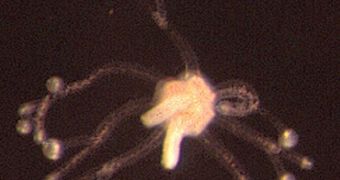They have not created a 3-headed dragon yet, but by now scientists have managed to make a jellyfish with a dozen heads by carefully monkeying with a few genes. This experiment could explain how natural colonies of other multi-headed organisms first emerged, like that of the reef building corals.
Researchers focused on the so-called Cnox genes, which control the embryonic development of the jellyfish. The closely related Hox genes have the same function in humans.
The experiment's species was the European hydromedusa (Eleutheria dichotoma), collected from the southern France. (In Greek mythology, Hydra was a monster with countless heads, while Medusa, "jellyfish" in many modern languages, had writhing snakes instead of hair.)
Special designed RNA molecules specifically "silenced" only the Cnox genes of the jellyfish. Normally, the saltiness of these animals would impede those RNA molecules from intruding into their cells, but the scientists diluted seawater with freshwater enough "where the jellyfish still survived and the RNA got in," said evolutionary biologist and invertebrate zoologist Bernd Schierwater at the Hanover University of Veterinary Medicine in Germany.
When the Cnox-3 gene was inhibited, two normal heads often developed. They were both completely functional, taking food for example. But the inhibition of the Cnox-2 triggered the development of over 2 heads, "up to a dozen," Schierwater told LiveScience.
Cases of polycephalic (with many heads) animals in nature are rare, as two or more heads could not be an advantage in the race for survival.
Still, the corals often develop colonies by adding heads to a common stalk, each of which linked to a common gut, exactly like the case of the engineered jellyfish.
Jellyfish and corals are close relatives; they are both carnivores forming the group called cnidarians ("stinging nettles"), due to their poisonous stingers.
"The solitary ancestors of corals and other colonial organisms might have adapted genes related to multiple heads long ago in such a way that animal colonies were able to emerge." said Schierwater.
It seems now that the suppression of just a few genes could have triggered the incredible variety in body plans "from the very beginning," explaining "the evolution and development of animal life in general." said Schierwater.

 14 DAY TRIAL //
14 DAY TRIAL //